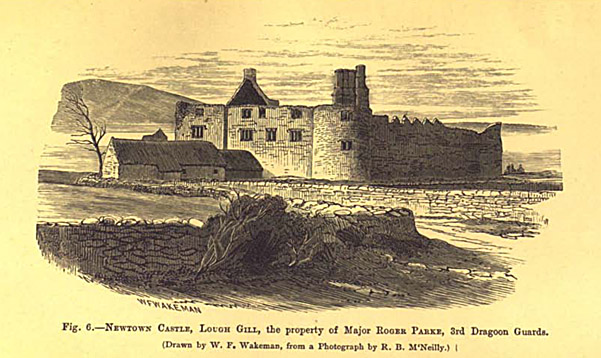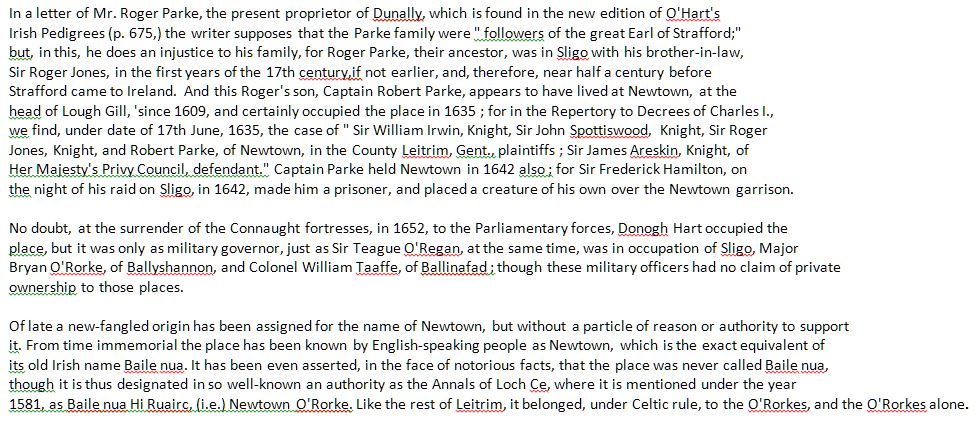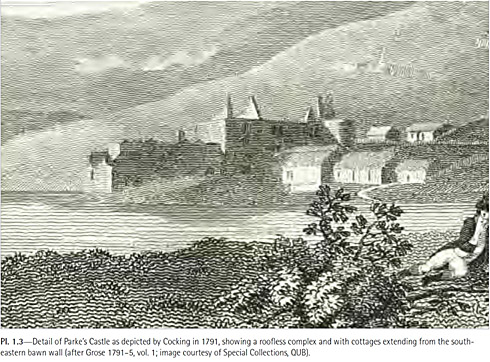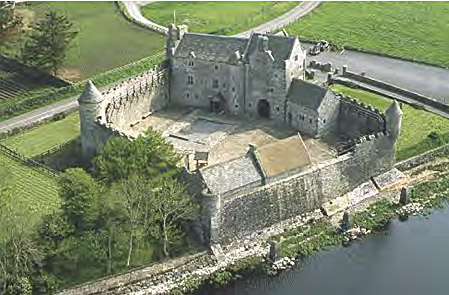Provenance of Parke’s Castle, which appears to have been built in the early 1600s and was previously known as Newtown Castle, has been not entirely clear:
In History of Sligo, County and Town by Major W. G. Wood-Martin (1882), there is a drawing of Newtown Castle:

The Major Roger Parke, referred to in the caption, is the same person referred to on page 674 of O’Hart’s Irish Pedigrees or The Origin and Stem of The Irish Nation, Vol 1, 1888 Dublin, where we read:


O’Hart offers the note:

We see that Roger Parke had a different opinion as to the original owner/builder of Newtown Castle, and also offered a brief history of his own home, Dunally. His belief that his family were followers of Strafford is challenged in The History of Sligo: Town and County by T. O’Rourke (1889), Dublin where we see, on page 464:

With the passage of time, the building assumed the name Parke’s Castle (after the occupancy by Captain Robert Parke) and the changing ownership remained ‘clouded’ even when, following archaeological excavation of the site, the Board decided to renovate the castle.
In 1971 the site was being used as a depot for the Office of Public Works (OPW), which desired to insert a toilet in the south chamber of the gatehouse. A programme of archaeological excavation was directed by the National Park and Monuments branch of the OPW. Excavations were conducted in several phases between 1971 and 1975 before the OPW decided to restore the castle as an educational and tourist attraction. The site was gradually recognised as being of particular importance which could provide new insights into the early 17th-century Plantation period of County Leitrim.
In 2005, the National Monuments Service of the Department of the Environment, Heritage and Local Government (now the Department of Arts, Heritage and the Gaeltacht) appointed the Centre for Archaeological Fieldwork at the Queen’s University of Belfast to prepare an excavation report. Assessment of the site excavation archives led to the conclusion that “the construction of a comprehensive, chronologically phased sequence of development for the site was pivotal to the production of the final publishable report. In addition, the artefact assemblages would have to undergo specialist analysis and the historical, social and economic context for the site would need to be established, at both a local and a national level.”
In what is a definitive study of the archaeology and history of the site, (Foley, C., & Donnelly, C. (2012). Parke’s Castle, Co. Leitrim: archaeology, history and architecture. (Archaeological monograph series ; 7 ). The Stationery Office, Dublin.), the authors present the historical context, describe the architecture and archaeological findings, and describe works carried out by Captain Robert Parke.
This publication is a “must read” because of the extensive detail presented. As well as presenting many drawings and photographs of the ruined castle and stages in its excavation and refurbishment, a more accurate description of timelines and owners is presented.
The drawing, below, is taken from page 3 of this publication:

and a photograph from 1926 is shown on page 18:

Restoration of Parke’s Castle
The OPW extensively restored the castle between 1980 and 1988. Local carpenters restored the stairs and roof using techniques from the 17th Century. William (Willie) Parke (of Derrygonnelly, County Fermanagh) provided a family tree that was referred to in publications about the restored castle. In a personal communication, Willie admitted that there were errors in the submitted tree.
An aerial photograph of the restored castle, included in the publication:

![]()
Brief précis of evidence pertaining to ownership of Newtown Castle:
| 1400s | The authors of the report believe it to be plausible that the O’Rourkes erected a stone tower-house, using stone cut from a surrounding 3m deep ditch. |
| 1542 | Brian Ballagh O’Rourke submits to the authority of Henry VII under a Tudor policy of ‘surrender and regrant’. |
| 1545 | War breaks out between Brian Ballah O’Rourke and the son of O’Connor Sligo. |
| 1546 | Treachery unfolds against Brian Ballagh O’Rourke in his own town Baile Nua’ (Newtown). |
| 1562 | Brian Ballagh O’Rourke dies and a power struggle ensues between his sons. |
| 1577 | His son, Brian na Murtha O’Rourke, described as ‘of Newtown in the county of Sligo’ agrees with Sir Nicholas Malby to pay rent to the queen. |
| 1581 | Brian na Murtha has Leitrim, Newtown and Dromahair castles “broken down” for “fear the Saxons would occupy them”. |
| 1585 | The ‘Indenture of Leitrim’ restores to him, amongst other lands, Newtown. |
| 1588 | Brian na Murtha shelters survivors from the Spanish Armada. Sir Richard Bingham attempts a surprise raid on Newtown, but Brian na Murtha flees across Lough Gill. |
| 1590 | Brian na Murtha flees to Scotland, where James VI of Scotland surrenders him to the English. |
| 1591 | Brian na Murtha stands trial at the Tower of London. |
| 1592 | Brian na Murtha executed at Tyburn. His 2 sons are Brian Oge O’Rourke and his half-brother Teige O’Rourke. |
| 1603 | King James I of England grants Teige O’Rourke, amongst other possessions, ‘castles, lordships or manors’ of Dromahair, Leitrim and Newton. |
| 1606-7 | Teige O’Rourke dies and his young heir Brian becomes a royal ward. |
| 1617 | A jury finds Brian and his brother to be illegitimate. All the lands revert to the crown. |
| 1617-20 | Surveying and plantation of Leitrim |
| 1625 | The estate that included Newtown is granted to Sir William Irving a ‘gentleman usher of Charles’ privy council’. Irving surrenders the lands in spring and on 25th May, Charles grants the lands to Sir John Spottiswood. |
| 1627 | The Lord Deputy stays the grant (due to a question of debt) but King Charles I directs that it be immediately transferred. In October, Spottiswood is granted a licence to alienate lands in County Leitrim to Sir Roger Jones and Henry Park*. |
| 1628 | On 18th November, a licence is granted to Robert Parke to hold a weekly market and two fairs per annum at Newton. |
*I believe this Henry Park could actually be Roger Parke
Ownership of Parke’s Castle
Robert Parke is believed to have occupied Newtown from around 1630 and to have carried out building works on the site.
Archaeological evidence suggest that he rebuilt the eastern bawn wall, giving it gun loop merlons and crenellations, as well as cobbling the courtyard and construction of the gatehouse and towers at the north-east and north-west corners. He also added corbelled turrets at the south-east and south-west corners.
It also appears that, in a later stage, he added a new masonry manor house between the gatehouse and the rebuilt eastern bawn wall.
He is believed to have lived in the castle, except for some periods during the decade of turmoil following the 1641 rising and up to 1852, until he died in 1671, leaving the castle to his daughter Anne, wife of Sir John Gore. By 1678 she was widowed and signed an agreement with her son Robert Gore ‘of Newtowne’:
| 1671 | Ownership passes to his daughter Anne Gore. |
| 1678 | The castle is, apparently, occupied by her son Sir Robert Gore |
| 1688 | The castle is garrisoned by local Protestants. |
| 1705 | Sir Robert Gore dies and ownership devolves to his son, Nathaniel. Nathaniel marries in 1711, at which time the castle appears to be referred to as Newtown Gore, but he does not appear to have occupied the castle. |
| 1791 | Drawings by Thomas Cocking show the castle to be ruinousn. |
| Up to ~1837 | The castle remains in the Gore family. |
| ~1850 | The castle is owned by Burton Phibbs. |
| 1871 | Parke’s castle purchased by Roger Charles Parke of Dunally. |
| 1889 | Roger Charles Parke dies and the castle is inherited by William Robert Johnstone Parke (his brother). |
| 1914 | Benjamin William Parke of Dunally (a distant cousin) sells the castle to the Congested Districts Board for division of the land amongst the surrounding tenantry. |